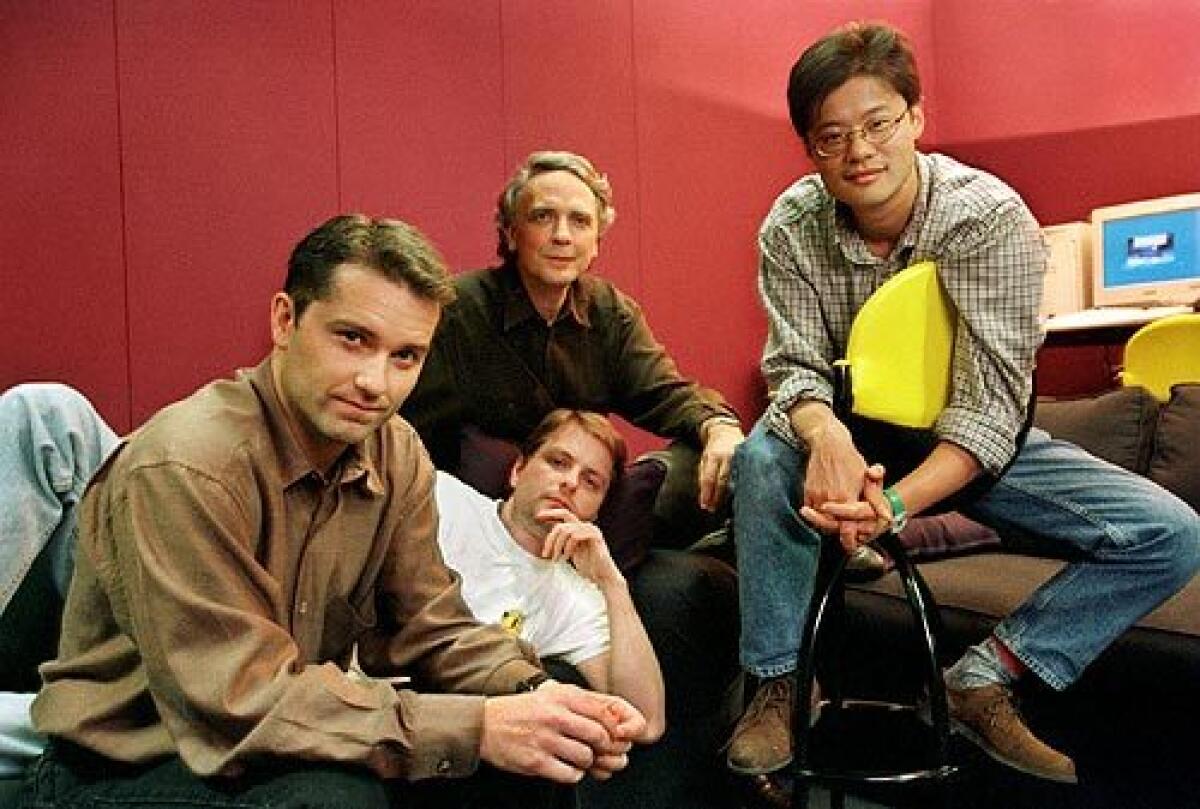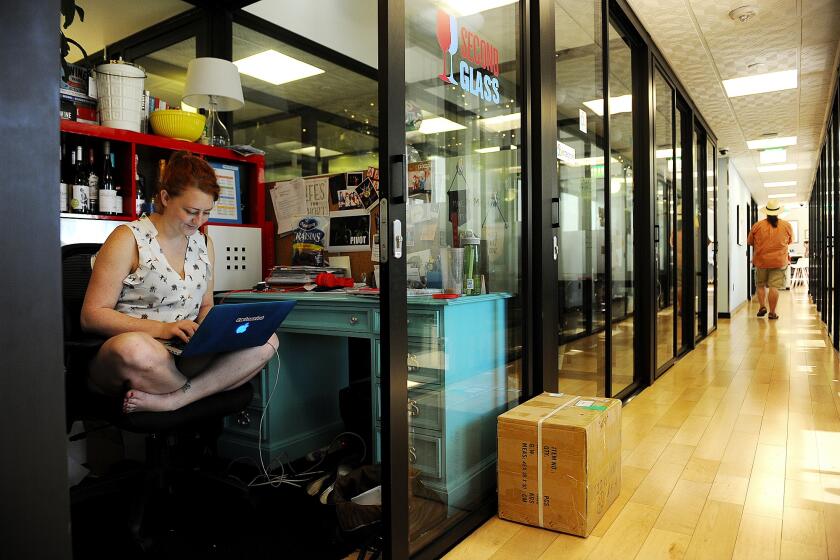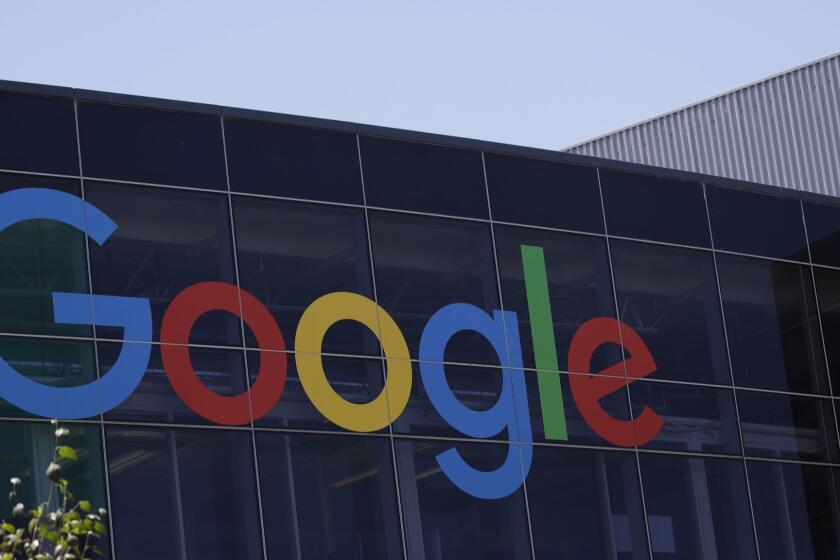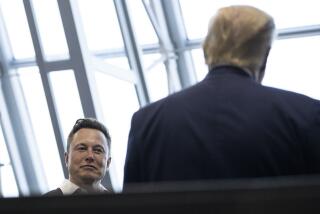I joined a tech start-up in 1998, before the bust. Today’s scene feels familiar

- Share via
It was two decades ago, but I remember exactly where I was when I got the call. At the time, I was a mid-level magazine journalist, working in a dark, low-ceilinged office in New York, spending hours upon hours rewriting prose sent in by correspondents from abroad. It was there, in my tiny office strewn with empty coffee cups, that I picked up the phone to a headhunter who told me that a group of London investors was keen to have me join it to build “scale” and “synergy” in the burgeoning European internet market.
I was breathless with excitement. In the late 1990s, pretty much anyone under 40 with loads of ambition wanted to be in the dot-com “space.” The company I was being wooed by was a high-tech incubator called Antfactory, a start-up venture group comprising former investment bankers and emerging market investors, looking to scout — wait for it — “pan-European b-to-c media deals.” In English, that meant internet media businesses that would produce content for consumers across the continent.
In retrospect, the fact that a bunch of rich guys with very little operational experience were willing to hire a journalist who had never worked in either technology or finance as a partner in their firm, and give her a six-figure salary and thousands of stock options, was clearly a sign of a market top. It didn’t feel like it then, though. This was my opportunity to jump on the first dot-com bandwagon. And, reader — I did.
Nothing about WeWork looks normal, and Wall Street may finally be waking up
I’ve thought about this period in my life a lot in recent years, as the technology sector has risen to ever frothier heights. A record amount of money has been poured into the sector over the last decade. The advent of huge venture funds such as Japan’s SoftBank has added fuel to the market. (SoftBank helped push up the value of WeWork parent We Co., which ultimately pulled its IPO.) Shares in once-touted unicorns such as Uber and Lyft have been falling.
And yet, the money keeps flowing. One of Silicon Valley’s oldest and most respected funds, Bessemer, recently announced a new bucket of money to invest in later-stage start-ups that want to stay private longer, presumably to avoid the fate of WeWork. All this sounds very familiar to me.
At the turn of the millennium, the tech frenzy was still new. Internet use was becoming the norm as connectivity improved. People were actually excited to use a Yahoo email address. Amazon wasn’t scary but cool, so much so that Jeff Bezos was named Time’s 1999 Person of the Year. It was the same year that Americans’ online Christmas shopping doubled.
The tech market was different back then — frothy, yes, but also fresh. In retrospect, though, it also had much of the hype that I have felt in the technology sector over the last couple of years. Then, as now, all asset classes had boomed in sync, fueled by deregulation, loose monetary policy and too much debt. Tax relief had thrown kerosene on a hot market — one of the triggers for the dot-com bubble 1.0 was the Taxpayer Relief Act of 1997, which lowered the top marginal capital gains tax rate in the U.S. from 28% to 20%, and in turn made more people more interested in becoming speculative investors.
Then, as now, too few people were thinking about experience, or long-term value, or even profits. They were looking for highly mobile young tech enthusiasts who could, as Uber co-founder Travis Kalanick would later put it, “always be hustling.” Antfactory’s Panglossian goal was to become the Idealab of Europe; a place where start-ups would be not only funded but also created and shaped. In those very far-away-seeming days of “Cool Britannia,” it somehow managed to persuade a range of companies including Citigroup to give it $120 million to invest in European dot-com start-ups.
For founders like WeWork’s Adam Neumann, gargantuan funding offered an opportunity — or an imperative — to double down on unproven and money-losing business models.
The investors found me because I had just written a cover story for Newsweek on Europe’s internet boom. “Europe’s Got Net Fever,” screamed the headline. “The Symptoms Are Clear — Hot New Companies, Job Offers Featuring Ferraris and a Certain Swagger as Bright Young Businessfolk Stake Their Claims in Cyberspace.” Yes, it’s a bit embarrassing to write these words now. If I had thought much about it, I would have realized I was coming in as the roller-coaster was shifting into free fall.
The slide began a little over a year after that cover. But there was still plenty of time to spin a story of building “scale” and “synergy” in the as-yet-fragmented European internet market. Unlike the U.S., which already had a base of 121 million users who spoke the same language and wanted to buy more and more of the same stuff online, Europe was a collection of countries, each with a unique culture and individual internet markets; the euro had only just been introduced. But optimism was the common language.
Antfactory, its founders touted, as they collected checks from established investors in London, would sit in the center of it, leveraging these wonderful new economies of scale. It would find the best European dot-coms — in travel, in music, in finance, in health — and mash them together, boosting their global presence and stock valuations. Exchanges from London to Frankfurt to Paris would compete to take these new companies public. Riches would be had by all. After all, why have six different travel-booking sites (serving France, Italy, Spain and so on) when you could have one?

The idea of trading in the punishing demands of reporting to partake of the riches of the internet was certainly on my mind as I considered Antfactory’s offer. I loved being a journalist, but it offered a predictable trajectory: Write more features, maybe become a senior editor or a columnist, watch my salary inch up by a paltry 2% every year. Antfactory, on the other hand, offered something new and inherently appealing to a business journalist: the chance to get into the game rather than just write about it. I told the Ants that I’d come to London to discuss the offer.
The partners, as it turned out, didn’t know much more about technology than I. One had worked mostly in entertainment and luxury brands. Two others were London finance guys, including one whose family was big in Greek shipping. I was a good enough reporter to appreciate the shortcomings of the team. Still, the idea of being able to waltz into a high-tech incubator as a partner and scout deals at the height of the dot-com boom was exciting. The stock options might actually be worth something. In a worst-case scenario, I told myself, I would go back to journalism knowing a lot more about the tech industry than I did before I worked in it.
After landing their first major round of investment in 2015, the co-founders of one of L.A.’s fastest-growing start-ups had to make a major decision.
I moved to London in December 1998 and plunged into the dot-com scene, where I soon encountered a networking salon-cum-headhunting site called First Tuesday. It had been founded in part by Nick Denton, a former Financial Times journalist who would eventually go on to start Gawker, and a Silicon Valley transplant named Julie Meyer. Both of them were more businesspeople than technologists. The DNA of the London start-up scene reflected the DNA of the city itself: It was about money and dealmaking.
Of that, there was plenty. New jobs — and new companies — were being posted on First Tuesday’s website every few minutes. At networking events, Denton and Meyer made it easy to see where the money was — potential investors wore red dots on their lapels; the “talent” wore green. The reds, who were rarer and inevitably more popular, would often emerge exhausted after fighting off eager greens over cheap wine and snacks. The group claimed that $100 million worth of deals had been cut in this manner. I didn’t really believe them, but I didn’t entirely not believe them.
Either way, one thing was clear: There was money to be made. It was the roaring ’90s, after all, in London as well as in Silicon Valley. It was a period when the notion of retiring comfortably with a gold watch and a pension began to slip away, replaced by soccer moms reading Money magazine and hoping to become stock-picking millionaires overnight. My own mother, a first-grade teacher, was — incredibly — dabbling in biotech stocks, an experiment that shaved 30% off her retirement.
Antfactory was, essentially, doing the same — dabbling in things nobody knew enough about. But it was clear to me that the people in charge didn’t have the experience and insight to pull it off. Most of the opportunities we were looking at were copycats of successful start-ups that had already launched, or ill-advised attempts to create internet arms of existing legacy brands. Although the founders kept a deal flow going and the press kept writing naively positive stories about London’s homegrown tech incubator, internally the firm was already starting to revert to what it really was — a collection of ex-London bankers looking to make a quick buck.
When you pull back the lens, that’s really what much of the late 1990s/early 2000s dot-com boom was all about. Far away in Silicon Valley, a handful of companies such as Google, Amazon and PayPal were carving out sustainable niches — and then ring-fencing those markets. Then there was everyone else. As Hal Varian, who would become Google’s chief economist, put it in 2001: “The obvious corollary to winner-take-all is loser gets nothing, and there will inevitably be many more losers than winners.”
After a years-long drought, a wave of technology start-ups — Uber, Lyft, Pinterest and more — are going public, evidence that the sector is thriving.
True enough. But the frenzy of financial activity was being fueled by more than just your typical market forces. In retrospect, it reflected the increasingly tight links between the world’s financial capitals and tech hubs, and the halls of power in places like Washington and Brussels. The tech industry had lobbied successfully in the 1990s against new accounting standards that would have forced companies to mark the value of options on their books. Today, companies such as Apple and Google can take advantage of ultra-low interest rates (which themselves were a response to the 2008 crisis) to issue loads of bonds on debt markets and then use the proceeds to pay back the richest shareholders in the form of tax preferential buybacks and dividends, further increasing the wealth divide.
Back in early 2000, a different problem was emerging: The dot-com boom was turning to bust. The value of the Nasdaq index peaked on March 10, 2000.
It’s incredible how similar the negative sentiment around tech seems today. Then, as now, companies were starting to issue reversals of revenue statements, and investors began to realize that many previously lauded start-ups were more style than substance. Once the Federal Reserve decided to raise interest rates, the die was cast. The “easy money” had officially run out. Or at least until it was time to reflate the market and create tech bubble 2.0.
By September 2001, Antfactory’s investors had lost patience with the leaders and demanded they return a $120-million cash pile and wind down the firm.
I often think about those disastrous years and wonder what has changed in the tech world — and what hasn’t. Today’s tech market is so much more developed, with vastly better infrastructure and game-changing innovations such as ubiquitous smartphones. We are only just beginning to move into artificial intelligence, the “internet of things,” 5G and other areas that many businesses are counting on to propel revenue growth in the future. Certainly, it is harder for companies to receive funding just by sticking “.com” behind their names.
Still, there are many things about the current economy that remind me of my time in London. Then, as now, we were in the late stages of a credit cycle, with too much money chasing too little value. Investors who were counting on a spate of hot IPOs to buoy the late stage of a boom market were disappointed.
Technology companies have been hiring at such a rapid pace that they have come to rule the Los Angeles office market and are spreading their influence into neighborhoods such as Silver Lake and West Adams that were not previously considered white collar business centers.
Back then, the infamous Pets.com went out of business nine months after its IPO. The turning point this time may be Uber’s IPO in May, one of the most anticipated in history but, in the end, a dismal failure. It marked a top in tech stocks that simply don’t make any money, despite their size and disruptive power.
It’s only the beginning of what I suspect will be a long fall for Big Tech. From 2008 onward, Silicon Valley took the place of Wall Street as the global hub of corporate wealth and power, creating the world’s first trillion-dollar business, growing companies with more users than the planet’s largest countries, and reshaping everything from our brains to our elections. But just as finance faced an existential crisis a decade ago, so Big Tech is facing one now. The U.S.-China trade and tech war is leading to a “splinternet,” which will make it much more difficult for digital giants to grow. There are calls from regulators and politicians on both sides of the Atlantic to clamp down on the size and power of the sector.
I never made any money from those Antfactory shares. In fact, demoralized by listening to people try to make nothing sound like something, I left the company several months before it went bust. But I learned a few things about bubbles along the way.
Rana Foroohar is the FT’s global business columnist. © The Financial Times Ltd. 2019. All rights reserved. FT and Financial Times are trademarks of the Financial Times Ltd. Not to be redistributed, copied or modified in any way.
More to Read
Inside the business of entertainment
The Wide Shot brings you news, analysis and insights on everything from streaming wars to production — and what it all means for the future.
You may occasionally receive promotional content from the Los Angeles Times.














